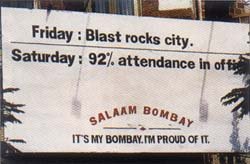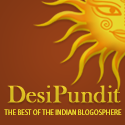Better people than I have written about it: Amit Varma is one, Desi Pundit will direct you to a host of others. People are helping: Mumbai Help is one such stop. And, inasmuch as there are answers in a situation like this, Suketu Mehta fields some questions on the bombings.
I was in college when the '93 bombings took place. And yesterday was such a bad flashback to that time. Trying to call, and not getting through.
In the random images that have flashed through my head, TV footage from last night mingles with odd fragments of memory. One such flash was the Salaam Bombay campaign that ran the day after the blasts.
I found these pics on agencyfaqs, Special Citation-winners at the Abbies in 1994:


And I found this post-9/11 piece by Vivek Kamath, who worked on the campaign at the country's hottest advertising shop then, Trikaya Grey:
A New York State of Mind
New York and Mumbai. Mumbai and New York. They have so much in common. Both cities are vertical in their architecture and in their ambition. Both have a phenomenal work ethic. And both are as vulnerable as an ice cube in a volcano.
Last week’s attack on New York brought back memories of Mumbai’s serial blasts in 1993.
Everyone has a story to tell about the blasts. Here’s mine: I was working at Trikaya Grey whose offices were at Kala Ghoda. When the stockmarket bombs went off, we heard a muffled thud and thought someone had dropped the photocopier on the mezzanine. Then, someone came in from lunch and said, people were bleeding on the street and stories of other blasts started doing the rounds. Some true, others unfounded. There were no mobile phones or Net connections then. The landlines were jammed by anxious family members and friends. After the riots of December 1992 and January 1993, fear covered the city like shroud.
But unlike December and January, these attacks were the handiwork of an outsider who was trying to destabilise Mumbai. And Mumbai refused to cower under the attack. In an overwhelming show of tenacity and resilience, the citizens of Mumbai pitched in to help the victims of the blasts. BEST buses doubled up as ambulances and sped the injured to the shelter of a hospital. Near the stock market, restaurant owners put up drums of drinking water. There were queues of blood donors at hospitals and by 9 pm, blood banks were full. Outside the passport office, people had formed a ring around the blast site and onset of set of volunteers helped the injured while one set diverted traffic.
One of Trikaya Grey’s clients was on his way home from the airport when he saw the devastation outside the passport office. But he also saw the spirit with which ordinary, everyday people were helping out. He got home and called Ravi Gupta (now no more but then the MD of Trikaya Grey). He told Mr. Gupta to do a campaign that saluted the spirit of this city. Use print, outdoor, radio, TV, T-shirts, buttons. Do what you must, he exhorted. But highlight these seemingly isolated instances of courage and bind them together in a campaign that unites the city and makes us proud to be a part of it.
But while he was willing to pick up the tab for the exercise, the client was clear that he did not want his logo on the campaign. He felt any ring of sponsorship around this message would smack off crass commercialization and dilute the message. Mr. Gupta called a meeting of six people (creative, client servicing and media) and briefed them. Don’t give me an “I love New York” kind of campaign, he said. I want pride, not love, he emphasized. He told us we would meet every two hours to review progress.
In less than 24 hours, the Salaam Bombay campaign was born. The strapline was It’s my Bombay. I’m proud of it. Billboards and print ads highlighted how, despite the serial blasts on Friday, there was 92% attendance in offices on Saturday. Of how trading resumed at the stock market on Monday. Armed with a blanket permission letter from the CM, six camera crews shot footage of the devastation and contrasted it with images of the city getting back on its feet. Kids at traffic lights sported Salaam Bombay T-Shirts. College kids distributed car stickers which motorists, for once, gladly put up.
The campaign made its point and sent out a signal. At least six multinats asked for copies they could send overseas so their headquarters knew Bombay was safe. Through it all, the man who initiated the entire exercise remained quietly in the background. But today, eight years later, I am taking the liberty of naming Mr. NS Sekhsaria of Gujarat Ambuja Cement.
Because as the destructive footage of last week’s events started to steam in. As economies collapsed and there was talk of war, I thought of Mr. Sekhsaria and I was filled with hope.
Because if New York and Mumbai have so much in common, there must be someone like Mr. Sekhsaria in New York. The world needs them right now. Quite, strong men of steel and vision, who always look at the silver lining. And think constructively even in the most destructive of times.
In these most destructive of times, my friends are safe. More than one has had the grace to wisecrack about working late saving their lives.
And, sure, the Bangalore I live in today seems a lifetime removed from the Bombay of 1992-93 -- with its curfews and unsettling undercurrent of violence, of maha aartis and staticky recordings of conversations over police scanners.
But I suppose that's just another illusion.





7 comments:
Thanks, was just windering before I logged on whether yoyu would ahve written soemthing on the topic. It was truly heartening to read it. That people not living here anymore, still find time to write stuff liek this is what I guess the famed "Mumbai spirit" is all about. Just wish sometimes that it did'nt remain limited to just these times. but, hey am not complaining.
I also was telling and infact discussing with the others in office that our penchant for working late at times liek these is what saves our skin. Some very convoluted yet life saving logic that!!
Pray for those who were nto as lucky as the rest of us.
Sorry about the typos, yikes too many of them.
Was up very early thsi morning :)
i remember the campaign - it was brilliantly done. i'm no expert, but i think that good indian ads are a lot more fun to watch than good american ads... then again, i'm biased...
Thank you so much for this heartening story. The more I want to dismiss Bombay's self-romanticism, the more I am forced to admit there's substance in it. he campaign idea was the best ad idea ever in his country, I'd say.
Numb: Couldn't not write about something's that's been on my mind so much. 7 years of living inother cities, and I still think of myself as a Bombayite first.
Great Ganesha: I still remember being struck by the fact the campaign broke the very next day of the blasts -- god alone knows how they pulled it off.
Shivam: It's tempting to dismiss the self-romanticism of Bombay. (And yes, the "Bombay spirit" draws heavily upon the quiet desperation of living from day to day) But there's something beautiful and brave about a people TRYING to rise above the crisis. It's the very same emotion I remember from '93.
I did not know that bit of history behind "Salaam Bombay" - have been seeing it at many places in the lasr few days (MTV top of screen, Hindustan Times front page) but O just thought it was a coincidence.
'salaam bombay' first comes from the movie of the same name released in 1998. the name had already spawned an ngo, in mumbai called salaam balak.
incidently the salaam bombay foundation in mumbai is run by the daughter of mr sekhsaria, and does some good work for guthka addiction and oralcancer patients.
Post a Comment